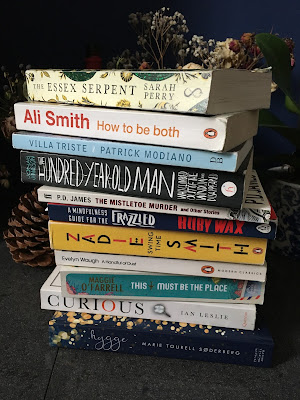A long-overdue round-up of some of my 2017 reads

Most atmospheric setting
Has to be the south of France, the setting of Villa Triste… with its enigmatic people, splendid hotels, endless champagne… my awful description does not do it the slightest bit of justice.Character I’d befriend
Ursula Todd in Life After Life. There are times when she could do with a pal.
Best for life lessons
A Mindfulness Guide for the Frazzled – not only does Ruby Wax navigate the thorny topic of mental health with wit and wisdom, she teaches you about the scientific make-up of the brain. This is a great way to understand the invisible nuts and bolts that make up our grey matter.
Place I’d most like to visit
The village in Africa that a large portion of Swing Time takes place in.
Biggest surprise
The Hundred-Year-Old Man Who Climbed Out of the Window and Disappeared was one surprise after the next. Each individual scene could have been far-fetched (and I distinctly remember my English teacher telling us not to include something as silly as having a pet elephant in our stories) yet they all worked. It was so satisfying to see all of the threads come together at the end.Most vicious villain
The murderer in P.D James’ A Very Commonplace Murder in The Mistletoe Murder and Other Stories. Nasty. See 'The unfinished one' for what I imagine to be a fuller character picture ofsuch a man!
The unfinished one
The Psychopath Test. This was an absolutely
fascinating read, but seeing the inside of mental asylums from days gone by all
got a bit too intense for me! If you’re interested in psychology, and what goes
into the making of a killer (see above!), this is one for you.
 |
| A Mindfulness Guide for the Frazzled by Ruby Wax. Impossible to be frazzled in this calming café! |
 |
| Zadie Smith's Swing Time hops between the UK, New York and a village in West Africa. |
Best nonfiction one
Curious: The Desire to Know and Why Your Future Depends On
It –
this is full of great anecdotes and case studies that illustrate why it’s important
to never stop asking questions. I think parents
and teachers would find this fascinating, as it looks at curiosity in children and
how education can help or hinder it.
Quick read
The Essex Serpent – I read this on holiday and powered through it in a few days. I really enjoyed the book, but the nerd in me hoped for a bit more science!Time period I'd like to visit
Between the wars in A Handful of Dust. People had to create a whole new set of social rules after the war. It must have been a baffling time to be alive.
The one to re-read
This
award goes to How to be Both. I have
more Ali Smith on my list for next year, as I think she’s brilliant, but I do
have to concentrate to make sure I don’t miss things! So I would like to revisit this when I am older and wiser.
If you only read one of these
This Must Be the Place – an accessible book that spans
generations, visits several countries, has a pacey plot and is written beautifully.
One of my new faves!





